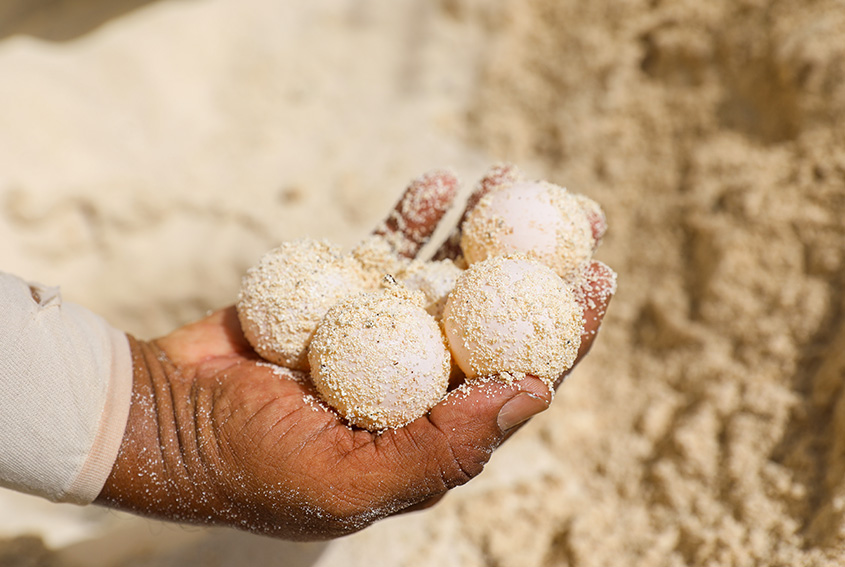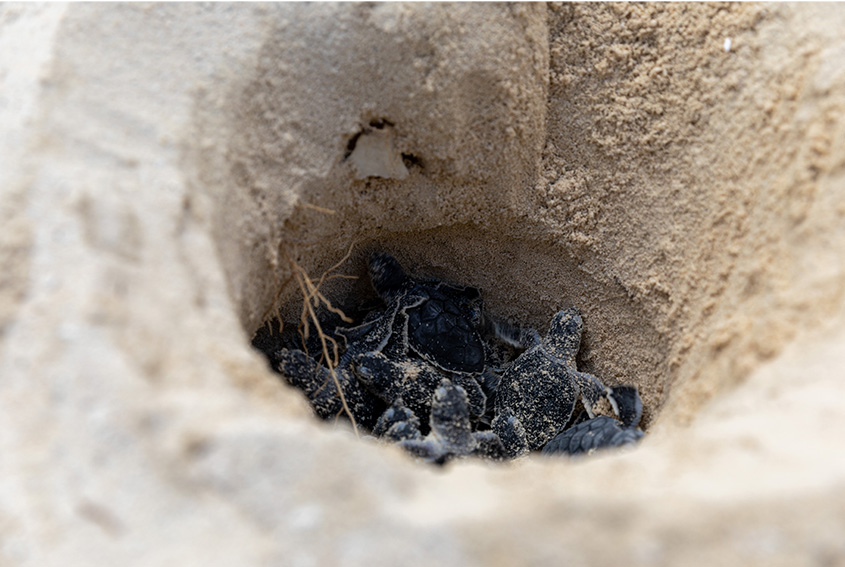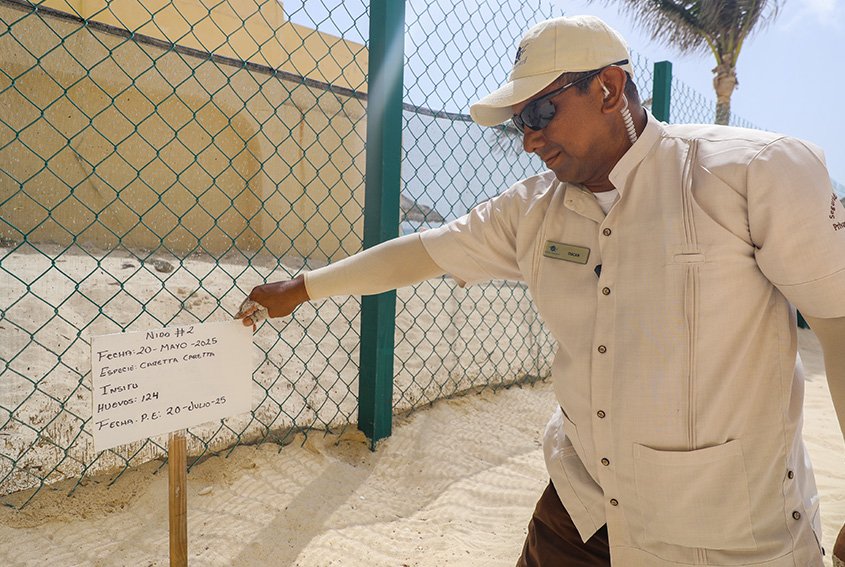Meet our turtle guardians – Blog
Royal Resorts is a Cancun sea turtle conservation pioneer, since 1985, it has been proud to protect this ancient creature which has been swimming the oceans for more than 120 million years. We couldn’t do it without our awesome turtle guardians, the security teams that patrol the beach every night during the season on the lookout for nesting turtles and watch over them as they lay their eggs. Meet Oscar, who talked to us about his work at The Royal Sands.

Originally from the oil town of Minatitlan in southern Veracruz, Oscar has been with Royal Resorts for 20 years and is passionate about being a turtle guardian, something he has been doing for 10 years. “The first time I saw a sea turtle was at The Royal Mayan, the resort where the company’s turtle conservation work began.” he reminisces. “I had never seen one before and I had to watch over a nesting leatherback, the world’s largest turtle species. She was huge, really majestic, I remember everything, down to the 70 eggs she laid.” The leatherback turtle is a rare visitor to the Mexican Caribbean and generally nests on beaches further south, in Central America.
Throughout the summer, Oscar patrols the beach from 10 p.m. until daybreak. “I love doing my bit to protect our special ocean visitors,” he says. “Seeing them emerge from the waves is such a thrill, it is something you never tire of. We stay with a turtle as she chooses her nesting site, digs a nest, lays her eggs and then returns to the sea. Each turtle is on the beach for around two hours. Sometimes they move around a bit, perhaps the sand feels too compact or something disturbs them before they settle on a site and start to dig. Our busiest time is from one to two a.m. and up to 4:30 a.m. On nights with a full moon, we may have as many as 25 turtles to protect during the night! The light draws them and we have to be careful that they do not go inland towards the pool deck.”
“We move loungers or chairs that could obstruct the turtle’s passage as she makes her way across the sand, and we make sure that beachgoers watch from a distance. Turtles are tremendously strong and once they start digging there’s a lot of sand flying through the air,” explains Oscar. “It is important to be quiet and bright lights and camera flashes are prohibited. If a turtle is startled she may leave the beach without laying her eggs. We try and educate visitors on turtle season rules as they witness this natural wonder.”

Once the turtle enters her egg-laying trance, Oscar and his teammates begin to collect the eggs and move them to the corral where they will be safe from predators such as seabirds. They make a nest in the sand that is the same shape as the one the turtle digs. Once they have done this, they cover it with sand and write the name of the species, date, time, number of eggs and the turtle’s measurements on a wooden sign. Then they wait. As the days pass, they start watching for telltale signs – a depression in the sand means that the eggs are hatching. They’ll soon see tiny flippers break through the sand and then the heads peeping out of the nest. There may be 100 to 120 tortuguitas born every night, and sometimes even more. The hatchlings keep their guardians busy. Oscar says, “I don’t know if it is the smell of the sea or just instinct, but once the turtles struggle free from the eggs they want to be off towards the waves, it’s an irresistible call. However, we have to wait until their umbilical cords shrivel and fall off before we can release them. We set them free after dark when predatory gulls and frigate birds have gone to roost, and we watch over them until they enter the sea.”
“The majority of the turtles that nest on the beaches of Cancun are green turtles, we get some loggerheads and the occasional hawksbill turtle, the smallest species to nest in the Mexican Caribbean,” explains Oscar. “They return to the same beach every year and we have noticed that some of them even have a favorite nesting site on the shoreline. We have one turtle that heads to the same palapa every year to lay her eggs, we call her “La Tumbadora” because she is so strong that she has been known to knock it over! She is very determined, we have to guide and protect her so that she doesn’t injure herself.”
Oscar and his teammates recognize other returning turtles. He says, “There is a turtle we call “La Mochita” because she only has one front flipper. It takes her longer to dig her nest and lay her eggs – three hours instead of two – but she always manages it and she comes ashore twice during the season. Then there are two that quietly stay close to the waves before nesting and then there is one that once stayed on the beach until 6 a.m.!”

“We have had turtles that lay up to 210 eggs,” he adds, “However, when there are that many eggs in a nest, they don’t all hatch or the young survive. If there are 100 or 110 eggs, we have a much better hatching rate, sometimes 100 percent.”
Before nesting season starts, biologists from the Municipal Environmental Department visit the resort to give the security guards a refresher course on turtle conservation rules and any policy changes, turtle biology, and how to handle them. Oscar says, “We are always learning something new about these fascinating marine creatures.”
Our turtle guardians are prepared for rain, wind and the occasional storm that may blow through the area. When that happens, they have to wait until the day that the storm’s landfall is expected. It’s a race against time and worsening weather conditions as they dig up the eggs in each nest and carefully put them in a sand-filled and labeled cooler. They move them to a storeroom where they will remain until the eggs hatch.
Oscar sums up his summer job, “I am so proud to be helping to protect the sea turtles, joining fellow “tortugueros” or turtle guardians throughout the Mexican Caribbean. It may be hard but I wouldn’t miss it for the world. From the moment we see a turtle come ashore to watching over the baby turtles as they race towards the waves, it is a beautiful experience, and I love to share it with our guests. Although they cannot touch the turtles – it is prohibited by law–, they can watch a turtle release and we try to tell them a little about the turtles and the eternal cycle they are witnessing.”
Since 1998, our turtle guardians have watched over more than 10,000 nests and released more than 1.2 million baby turtles. As of June 16, there are 41 nests in the corral at The Royal Sands and 4,972 eggs. All of us at Royal Resorts look forward to welcoming thousands more turtles to the world this summer.




